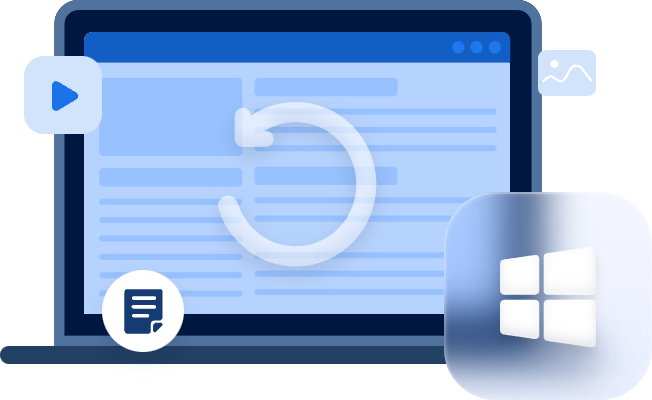How to Open DV Files and Recover Deleted DV Files?
Learn to recover deleted DV files via reliable video recovery software in this passage. Besides, there’s a recommended Windows backup tool for you to prevent DV loss at the source.
What is a DV movie format?
Born out of digital camera technology, the Digital Video file format uses a standard raw format to store video content.
Each DV (Digital Video) file comprises Digital Interface Blocks (DIF) and occupies 80 bytes per block, accommodating audio, video, and metadata. These blocks can be stored as raw computer files or wrapped within specific file formats.
In essence, DV files use lossy video compression, while audio remains uncompressed.
The past decades have seen the development of DV files and expanded their application to optical discs, solid-state flash memory cards, and hard disk drives.
Without a doubt, the DV file format has left an indelible mark on digital video recording and storage, offering a versatile and efficient means to capture and preserve multimedia content.
How to recover deleted DV files without backups?
Obviously, the DV (Digital Video) file format has been around for a long time, keeping old memories for us.
If you accidentally delete DV files from your camera’s SD card and don’t have backups, seeking help from reputable SD card video recovery software could be your top choice.
Unlike Windows’ Recycle Bin, the SD card does not provide a temporary storage folder for deleted files, making video recovery more changeling.
With a third-party tool like MyRecover, you can recover deleted/missing DV files from camera SD cards, computer hard drives, external hard drives, USB drives, etc.
SD Card Video Recovery Software:
- High-efficiency: Recover 200+ types of files such as videos (MP4, MOV, AVI, WMV, MKV, FLV, ASF, TS, 3G2/3GP, WebM, etc.) audio, photos, MS Office files, WPS files, folders, compressed files, songs, websites, etc.
- Advanced scanning method: MyRecover runs Quick Scan & Deep Scan automatically to search all the recoverable files. Specify the filename, saved path, date, or size to filter your needed files.
- Convenience: Retain the original filename, path, and format for the deleted files.
- Excellent compatibility: Support NTFS, FAT32, exFAT, and ReFS file systems and be compatible with Windows 11, 10, 8, 7, or Sever PC.
- Notes:✎...
- After video recovery, please save your retrieved DV files in another path instead of the original camera SD card.
- To recover large or more deleted/missing videos from local hard drives, upgrading MyRecover is a better and more cost-effective choice.
Step 1. Connect the camera SD card to your Windows > install and launch MyRecover > hover the mouse over your connected SD card > click Scan.
Step 2. After clicking Start Scan, MyRecover will automatically run Quick Scan and Deep Scan to scan your chosen D drive and show you all the recoverable files.
To quickly locate your desired DV files, you can preview or filter your needed videos according to Filename, Document Type, Date, Path, or Size.
- Name: Enter the filenames of your wanted files to narrow the search area.
- Date modified: Set the date (today, yesterday, last 7/30 days, etc.)
- Size: Filter the file size (<128KB, 128KB~1MB, 1MB~512MB, etc.)
Step 3. Under the Other Missing Files folder, choose the recoverable DV videos > click Recover x files.
What program opens a DV file?
DV files are compatible with numerous video editing and playback programs, rendering them highly accessible and widely supported across various platforms.
So please don’t worry about how to open DV files. You can use the corresponding utility to open DV files on different computer operating systems.
For example, Windows users could seek help from Windows Media Player, File Viewer Plus, VideoLAN VLC media player, MPlayer, Roxio Creator NXT Pro 9, CyberLink PowerDirector 365, CyberLink PowerDVD 21, etc.
Let’s demonstrate how to open DV files via Microsoft Media Player.
» Connect the camera SD card to your Windows > press Win + E to open File Explorer > right-click on your selected DV file > select Open with > Windows Media Player.
» For Mac:
- Apple QuickTime Player
- Apple iMovie 10
- Eltima Elmedia Player
- Roxio Toast 20
- Roxio Popcorn
- VideoLAN VLC media player
- MPlayer
- Kdenlive
» For Linux:
- VideoLAN VLC media player
- MPlayer
- Kdenlive
Related suggestions
What is a DV movie format? How to open DV files? Moreover, how to recover deleted DV files without backups? After reading the above content, you can find the right ways.
In addition, if you intend to convert DV to MP4, you can employ comprehensive VLC, which can help you finish file conversion.
To prevent data loss at the source, it’s highly recommended to develop a habit of making regular backups.
- You can try this free Windows backup tool called AOMEI Backupper Standard, which will help protect your valuable files and provide a reliable backup solution for the sake of unexpected data loss.
- Key features of AOMEI Backupper Standard:✎...
- Enable to back up files, folders, partitions, disks, or systems to an internal/external hard drive, USB stick, Network, or Cloud drive.
- Implementing intelligent backup strategies allows you to create daily incremental backups, effectively conserving storage space.
- By scheduling backups, you can ensure the continuous protection of your valuable data.
Step 1. Launch AOMEI Backupper on your Windows PC. Under the Backup tab, select the “File Backup” option.
Step 2. Click “Add Folder/Add File” to add the folder or DV videos you want to back up.
Step 3. Click “Schedule Backup” to enable Daily, Weekly, Monthly, Event triggers or USB plug based on your needs. Then click the “Start Backup” button.
By regularly backing up your data, you can ensure that your important files are safe and easily recoverable whenever needed.


